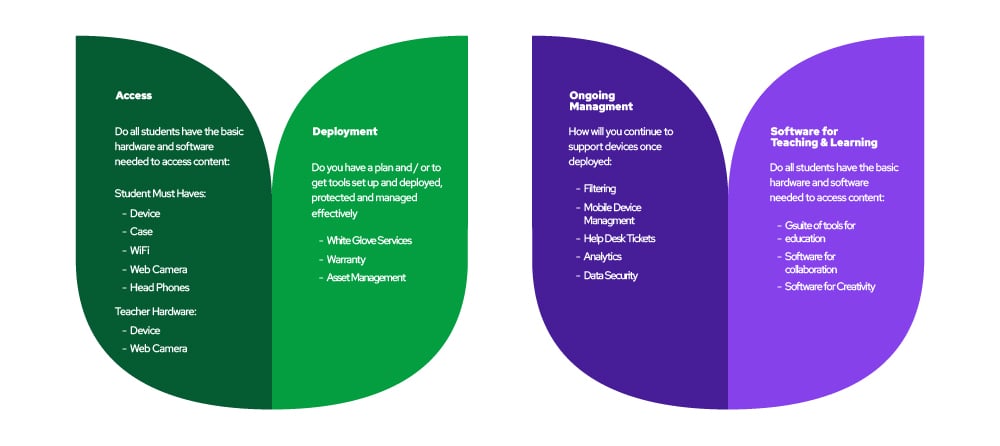In a blink of an eye, we have transitioned from a significant digital divide to an increase in technology access for most students. Those schools moving toward a 1:1 initiative have had their schedules accelerated over the past two years and many are struggling with how to procure, manage and update their devices.
IT departments had to quickly decide how the network would support the influx of devices. Instructional technology teams had to re-do their plan to shift instruction online and increase student engagement. They also had to change how they provided professional training opportunities.
As the demand for hardware increases quickly, the "peripherals" have hardly kept up. School districts understandably scrambled to get devices in the hands of their students. Some succeeded. Others didn't. Other considerations, like management software for district administrators, software for teaching and learning and professional development, were not adopted at the same rate as devices were deployed.
The Fork In The Road When It Comes To Investment
Investment in technology depends on the goals and challenges within an individual school or district. The global education technology market, valued at USD 76.4 billion in 2019, is expected to grow at a compound annual growth rate (CAGR) of 18.1% from 2020 to 2027.(1) Demand to connect and collaborate is the primary driver of the increase, but this growth comes with challenges. Let's explore the five points educators should consider in their technology investment journey.
Consider These Five Questions Before Making Edtech Investments
1. Do all students have the right technology needed to access content?
First, we must consider access to technology. Educators should check to see if all students have the necessary hardware, software and infrastructure to access the content. The student must-haves are devices, cases, Wi-Fi, web cameras and headphones, while teacher must-haves are devices, microphones, web cameras, network, classroom displays, speakers and cables. Beyond the recommended audio-visual technology, educators should consider all aspects supporting digital-age learning.
2.Do IT Directors Have A Plan To Get Tools Set Up, Deployed, Protected And Managed Effectively?
It's important to reflect on the current gaps in capabilities and pain points by having a deployment plan with complete integration and installation services. To make deployments easier, faster and less costly, IT directors should consider white glove services that provide K-12 schools with digital classroom configuration services. They should also find solutions that streamline the replacement of damaged items, track and manage devices and consider warranty plan options that protect their EdTech investments.
3.Do IT Directors Have A Plan To Continue To Support Devices Once Deployed?
How can we be sure that every device is set up with the appropriate settings, applications and filters to make devices safe and secure? Who is managing and measuring if the devices are working? Can tech teams handle ongoing updates and helpdesk needs remotely? These are just a few of the many questions that educators should consider to ensure that the ongoing management of devices is streamlined.
IT directors can manage their entire technology ecosystem with software. They can support every device with an all-in-one device mobile device manager, leverage data analytics to identify overspending, bolster off-site filtering to keep students safe and leverage virtual helpdesk capabilities that students and teachers can use to let IT know when devices fail.
4.Can Educators Enrich And Monitor Student Engagement When Students Are Working On Devices?
Teachers, administrators and instructional technology departments work overtime to transform in-classroom learning into engaging and inspiring virtual experiences. Even though every state, city, district and school has different learning needs, the goal remains the same: to build a classroom community and culture and maintain rigorous engagement with grade-level content through a flexible learning environment.
Creative and collaborative software solutions have become a cornerstone of providing powerful learning experiences for students no matter where they are. Software that enables students to be content creators and allows for collaboration in real-time is extremely powerful in any learning environment teachers and students find themselves in. When determining which software to bring into a district or classroom, it’s important to start by identifying the end goal. Are we hoping students will have an opportunity to create video – musical or audio content? How about engagement with STEM learning and creativity? Perhaps the goal is to include more equitable discussion within a class. All of these (and more) can be accomplished if educators enrich and monitor student engagement with software for teaching and learning.
5.How Can Learning And Development Help Educators Make The Most Of IT Investments?
The difference between barely surviving this unpredictable time and truly thriving and making the most of the technology investments is professional development (PD). PD is a catch-all word covering everything from product orientation and "how-to" training to a more in-depth pedagogical application, lesson design and ongoing coaching. How school districts approach PD is as unique as the school district itself.
These decisions are based on teachers' experiences, support teams and the time and budget available. Working with trusted professional development partners who have extensive experience in both the technology and the subject area can provide powerful learning that can facilitate long-term change.
 Five checkpoints to guide educators in their technology investment journey.
Five checkpoints to guide educators in their technology investment journey.
Focus On The Future With A Long-term Edtech Investment
EdTech products are everywhere. Educators should ask these important questions before committing to any new products.
Are you looking for a custom program for your school, or are you having challenges with what steps to take next in your tech journey? Let's nail down the details together. It does not matter what technology you have or whom you purchased it from. Our approach can help optimize any education investment! Here’s how to build a digitally responsive organization.
Sources
- Grand View Research, July 2020. Education Technology Market Size Report, 2020-2027


